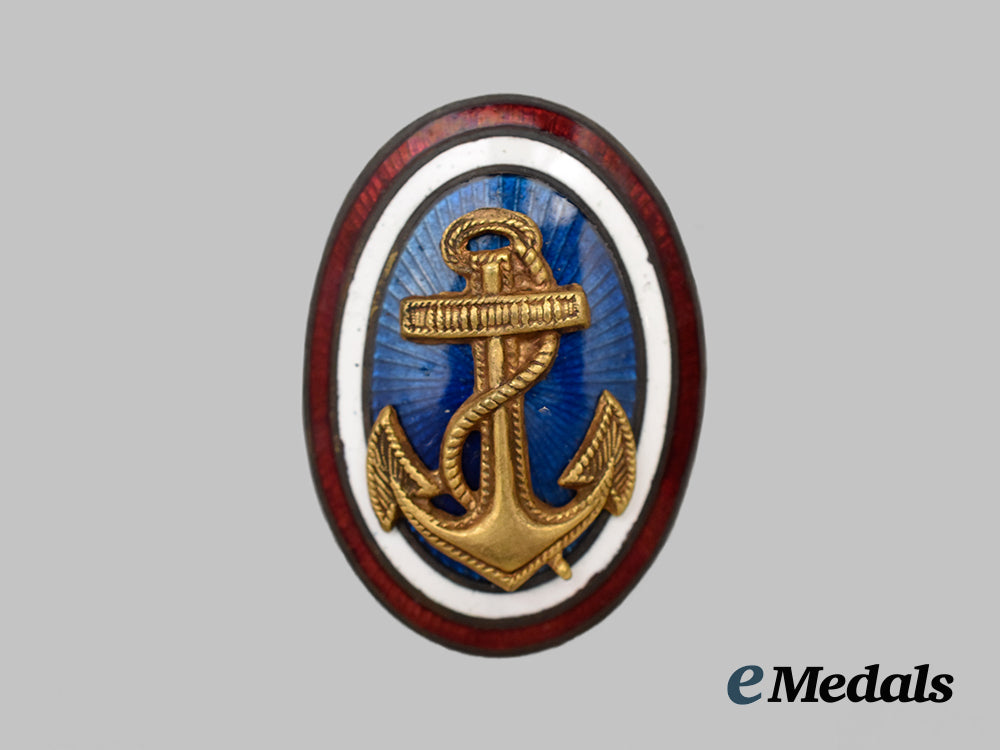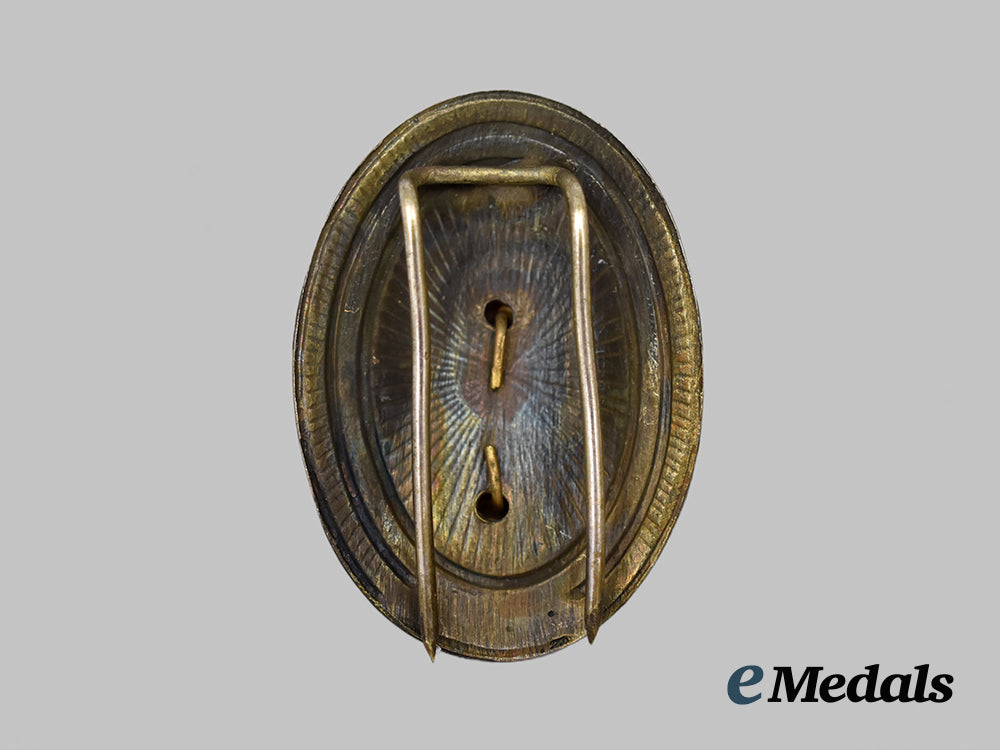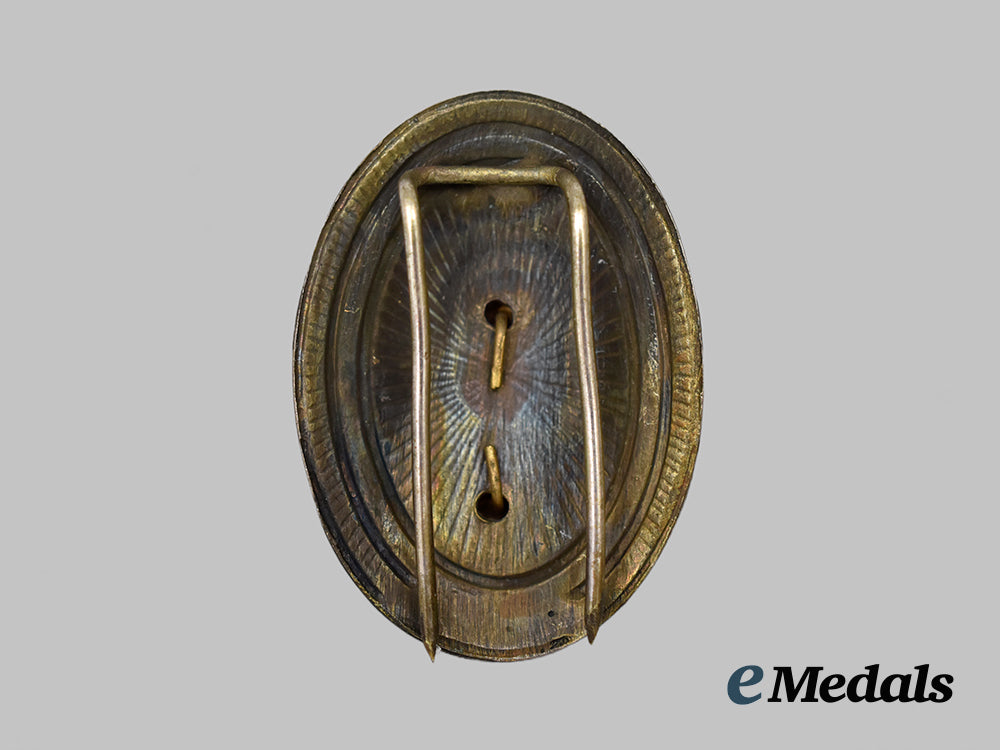
LOADING ...
In response to evolving domestic opinion, eMedals Inc has made the conscious decision to remove the presentation of German Third Reich historical artifacts from our online catalogue. For three decades, eMedals Inc has made an effort to preserve history in all its forms. As historians and researchers, we have managed sensitive articles and materials with the greatest of care and respect for their past and present social context. We acknowledge the growing sentiments put forth by the Canadian public and have taken proactive actions to address this opinion.


Yugoslavia, Kingdom. A Navy Officer's Cap Badge, c.1935
Yugoslavia, Kingdom. A Navy Officer's Cap Badge, c.1935
SKU: ITEM: EU22149
0% Buyer's Premium
Current Bid:
Your Max Bid:
Bid History:
Time Remaining:
Couldn't load pickup availability
Shipping Details
Shipping Details
eMedals offers rapid domestic and international shipping. Orders received prior to 12:00pm (EST) will be shipped on the same business day.* Orders placed on Canadian Federal holidays will be dispatched the subsequent business day. Courier tracking numbers are provided for all shipments. All items purchased from eMedals can be returned for a full monetary refund or merchandise credit, providing the criteria presented in our Terms & Conditions are met. *Please note that the addition of a COA may impact dispatch time.
Shipping Details
eMedals offers rapid domestic and international shipping. Orders received prior to 12:00pm (EST) will be shipped on the same business day.* Orders placed on Canadian Federal holidays will be dispatched the subsequent business day. Courier tracking numbers are provided for all shipments. All items purchased from eMedals can be returned for a full monetary refund or merchandise credit, providing the criteria presented in our Terms & Conditions are met. *Please note that the addition of a COA may impact dispatch time.
Description
Description
Two-piece construction, anchor insignia in bronze gilt and mounted via two pins to an oval-shaped base in silvered bronze with red, white and blue enamels, measuring 25.5 mm (w) x 35.8 mm (h), dual prong vertical pinback, better than extremely fine.
Footnote: The Royal Yugoslav Navy, was the naval warfare service branch of the Kingdom of Yugoslavia (originally called the Kingdom of Serbs, Croats and Slovenes). It was brought into existence in 1921, and initially consisted of a few former Austro-Hungarian Navy vessels surrendered at the conclusion of the First World War and transferred to the new nation state under the terms of the Treaty of Saint-Germain-en-Laye. The only modern sea-going warships transferred to the new state were twelve steam-powered torpedo boats, although it did receive four capable river monitors for use on the Danube and other large rivers. Significant new acquisitions began in 1926 with a former German light cruiser, followed by the commissioning of two motor torpedo boats (MTBs) and a small submarine flotilla over the next few years. When the name of the state was changed to Yugoslavia in 1929, the name of its navy was changed to reflect this. In the late 1920s, several of the original vessels were discarded. Throughout the interwar period, elements of the fleet conducted visits to ports throughout the Mediterranean, but few fleet exercises occurred due to budget pressures. In 1930, the Maritime Air Force was divorced from Royal Yugoslav Army control, and the naval air arm began to develop significantly, including the establishment of bases along the Adriatic coast. The following year, a British-made flotilla leader was commissioned with the idea that the KM might be able to operate in the Mediterranean alongside the British and French navies. In the same year, five locally-built minelayers were added to the fleet. A hiatus of several years followed, and it was not until 1936 that any further major acquisitions were made, with the purchase of eight German-built MTBs. Over the next two years, the fleet was significantly strengthened by the acquisition of three French-designed destroyers, marking the high point of Yugoslav naval strength. On the eve of the Second World War, the navy consisted of 611 officers and 8,562 men, operating 41 combatant ships and 19 auxiliaries. While the KM was largely captured by Italian forces during the German-led Axis invasion of Yugoslavia in April 1941, a few of its vessels, aircraft and their crews escaped and served in the Mediterranean under Royal Navy control during the remainder of the Second World War. When the Italians sued for peace in September 1943, most of the remaining vessels were taken over by the German Kriegsmarine or the Navy of the Independent State of Croatia. Towards the end of the war, the Allies transferred a corvette to Yugoslav control. At the end of the war, the few remaining vessels were transferred to the control of the new Federal People's Republic of Yugoslavia. As the post-war Yugoslav Navy drew its lineage from the naval forces of the wartime Yugoslav Partisans rather than the KM, few of the customs and traditions of the KM survived in the successor force.
Description
Two-piece construction, anchor insignia in bronze gilt and mounted via two pins to an oval-shaped base in silvered bronze with red, white and blue enamels, measuring 25.5 mm (w) x 35.8 mm (h), dual prong vertical pinback, better than extremely fine.
Footnote: The Royal Yugoslav Navy, was the naval warfare service branch of the Kingdom of Yugoslavia (originally called the Kingdom of Serbs, Croats and Slovenes). It was brought into existence in 1921, and initially consisted of a few former Austro-Hungarian Navy vessels surrendered at the conclusion of the First World War and transferred to the new nation state under the terms of the Treaty of Saint-Germain-en-Laye. The only modern sea-going warships transferred to the new state were twelve steam-powered torpedo boats, although it did receive four capable river monitors for use on the Danube and other large rivers. Significant new acquisitions began in 1926 with a former German light cruiser, followed by the commissioning of two motor torpedo boats (MTBs) and a small submarine flotilla over the next few years. When the name of the state was changed to Yugoslavia in 1929, the name of its navy was changed to reflect this. In the late 1920s, several of the original vessels were discarded. Throughout the interwar period, elements of the fleet conducted visits to ports throughout the Mediterranean, but few fleet exercises occurred due to budget pressures. In 1930, the Maritime Air Force was divorced from Royal Yugoslav Army control, and the naval air arm began to develop significantly, including the establishment of bases along the Adriatic coast. The following year, a British-made flotilla leader was commissioned with the idea that the KM might be able to operate in the Mediterranean alongside the British and French navies. In the same year, five locally-built minelayers were added to the fleet. A hiatus of several years followed, and it was not until 1936 that any further major acquisitions were made, with the purchase of eight German-built MTBs. Over the next two years, the fleet was significantly strengthened by the acquisition of three French-designed destroyers, marking the high point of Yugoslav naval strength. On the eve of the Second World War, the navy consisted of 611 officers and 8,562 men, operating 41 combatant ships and 19 auxiliaries. While the KM was largely captured by Italian forces during the German-led Axis invasion of Yugoslavia in April 1941, a few of its vessels, aircraft and their crews escaped and served in the Mediterranean under Royal Navy control during the remainder of the Second World War. When the Italians sued for peace in September 1943, most of the remaining vessels were taken over by the German Kriegsmarine or the Navy of the Independent State of Croatia. Towards the end of the war, the Allies transferred a corvette to Yugoslav control. At the end of the war, the few remaining vessels were transferred to the control of the new Federal People's Republic of Yugoslavia. As the post-war Yugoslav Navy drew its lineage from the naval forces of the wartime Yugoslav Partisans rather than the KM, few of the customs and traditions of the KM survived in the successor force.


You May Also Like
Germany, SA. A Model 1933 Service Dagger, SA-Gruppe Nordsee, by Friedrich von der Kohlen
G59818
Germany, SA. A Model 1933 Service Dagger, SA-Gruppe Pommern, by Gustav Wirth
G59816
Germany, Third Reich. A Mixed Lot of Tyrolean Marksmanship Badges
G52930
Germany, SS. An Estonian Waffen-SS Volunteer’s Sleeve Shield
G50381
Germany, SS. A Waffen-SS Sturmmann Sleeve Insignia
G52846
-
Germany, SA. A Model 1933 Service Dagger, SA-Gruppe Nordsee, by Friedrich von der Kohlen
G59818
Add to CartRegular price $980 USDRegular price $0 USD Sale price $980 USDUnit price / per -
Germany, SA. A Model 1933 Service Dagger, SA-Gruppe Pommern, by Gustav Wirth
G59816
Add to CartRegular price $980 USDRegular price $0 USD Sale price $980 USDUnit price / per -
Germany, Third Reich. A Mixed Lot of Tyrolean Marksmanship Badges
G52930
Add to CartRegular price $135 USDRegular price $0 USD Sale price $135 USDUnit price / per -
Germany, SS. An Estonian Waffen-SS Volunteer’s Sleeve Shield
G50381
Add to CartRegular price $150 USDRegular price $0 USD Sale price $150 USDUnit price / per -
Germany, SS. A Waffen-SS Sturmmann Sleeve Insignia
G52846
Add to CartRegular price $135 USDRegular price $0 USD Sale price $135 USDUnit price / per
Do you have a similar item you are interested in selling?
Please complete the form and our client care representatives will contact you.
Sell Item








